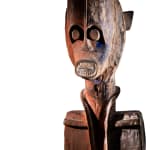 Water Spirit Statue
Water Spirit Statue
 Water Spirit Statue
Water Spirit Statue
 Water Spirit Statue
Water Spirit Statue
 Water Spirit Statue
Water Spirit Statue
 Water Spirit Statue
Water Spirit Statue
Anonymous Ijo artist
origin: Nigeria - early 20th century
58 5/8 x 7 1/2 x 6 1/4 in
Further images
This statue depicts the quintessential Ijo warrior. The white kaolin suggests the chalk markings worn by fighters. Indeed, Ijo warriors would go off into battle looking much like this figure, equipped with a medicine gourd around the neck and covered in war paint for protection. The Ijo believed that chalk, like the red camwood powder, had supernatural properties that could protect, purify, transform, and heal. The calabash attached to a necklace contained ‘bulletproofing’ medicines and associated the statue with masculine aggression. The bared teeth indicated powerful speech and an assertive personality. Typical for Ijo statuary are the protruding tubular eyes, strengthening the statue’s penetrating gaze. The vertical scarification line on the forehead as well was a typical Ijo identity marker. The slender physique and attenuated torso of this forest spirit figure deviate from Ijo stylistic norms. Such idiosyncrasy probably reflects the creativity of a talented individual artist. This exceptional Ijo bush spirit figure resembles an example photographed by Robin Horton in the south Central Ijo region in the 1950s. A second similar statue is held in the collection of the Art Institute of Chicago (#2000.321). The latter misses the raised left arm, which would indicate the supernatural nature of the represented bush spirit. All three statues share remarkably similar proportions. Horton identified the figure he photographed as a forest spirit named Kondou-bara-owei (“Left-Handed One”). People living in the Niger Delta, like many others in and beyond Africa, consider the use of the left hand to be antisocial, so left-handedness might perhaps reinforce the image of forest spirits as uncivilized beings. Almost life-sized, this rare statue surely leaves a lasting impression.
Provenance
Henri Guldemont Collection, Liège, Belgium
Philippe and Lisa Laeremans, Brussels, Belgium, 2008
Gérard Wahl-Boyer (aka Bébé Rose) Collection, Paris
Lisa Guldemont Collection, Liège, Belgium, 2022
Exhibitions
Publications
let's keep in touch
Join our community & never miss out on a DUENDE moment from now on
* denotes required fields
We will process the personal data you have supplied to communicate with you in accordance with our Privacy Policy. You can unsubscribe or change your preferences at any time by clicking the link in our emails.




